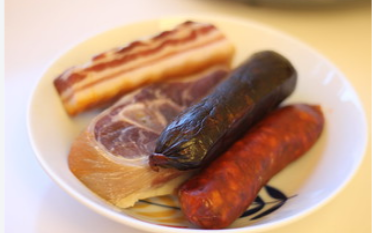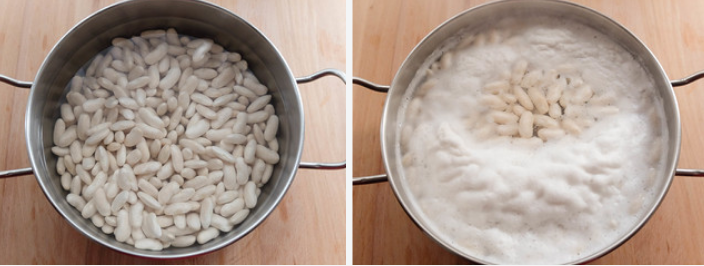 The Spanish love their "platos de cuchara". It is a fundamental part of the national gastronomy wherever you are in the country and a way of eating that defines real homemade hearty food in Spain.
The Spanish love their "platos de cuchara". It is a fundamental part of the national gastronomy wherever you are in the country and a way of eating that defines real homemade hearty food in Spain.
During the autumn and winter seasons, it will dominate the first course of any "menu del dia". Lentils and chorizo, Cocido (chicken, meat and vegetable stew), Chickpeas and Spinach, meat stews, rice soups and the recipe we will be looking at today, Fabada, are some of the dishes that will be appearing on menus across the country.
Basically, when they say "Plato de Cuchara" they are referring to the fact that you will need a spoon to eat it and bread to dunk in it! So, the season is here and the temperatures are dropping and a hot, filling dish is more appetising than ever, as is dunking crusty bread into a delicious broth.
Fabada Asturiana or simply fabada as it is more commonly known was logically from the northern Spanish region of Asturias. However, like many other dishes, it soon spread all over Spain and is recognised as one of the classic Spanish dishes.
Fabada is made with "fabes" (white beans in Asturian), several types of sausage and pork (chorizo, black pudding, bacon), as well as spices such as saffron and bay leaves occasionally. These extra ingredients are often referred to as the 'compango'.
Records referring to "fabes" go back as far as the 16th century, though its consumption was probably earlier than that. Like many other examples of Spanish food, fabada asturiana has rather humble origins as it was the poorer people who would mix fabes with any meat leftovers that they had from other dishes.
Some historians claim that the fabada recipe already existed in the 17th century, however, there are no documents that confirm this theory. Even though fabes is mainly a rural ingredient, and was cultivated in large quantities, it is believed that the dish itself was actually established in the poorer city neighbourhoods.
Some say it is similar to cassoulet from Languedoc in France that likely entered Spain thanks to the French who took the Camino de Santiago (Way of Saint James) during the middle ages when french pilgrims stayed at cities and towns along the way possibly sharing their recipes. However, the first written references for Fabada date back to 1884. Whatever the origin, it won't affect how you are going to love this dish.
Fabada is really easy to make, it's cheap and all the ingredients are readily available in all Spanish supermarkets. It is an ideal meal for large family gatherings.... even though they aren't possible right now due to the current coronavirus. Really, it only requires one major skill - patience.....So let's crack on and see how to prepare it...
Ingredients (4-5 portions):
500 grams of large white beans (dried)
250 of cured pancetta or streaky bacon
2 chorizos from Asturias
2 morcilla from Asturias - blood sausages
200 grams of cured ham bone - "hueso de jamon"
1 onion
2 garlic cloves
3 strands of saffron...more or less
Water
Salt

1. Wash the beans under running cold water and let them drain. Soak them in a bowl of water (they should be completely covered) the night before. Ideally, they should be hydrating for at least 12 hours.
2. Some use the same water to cook the beans, but ideally, I would drain them completely and use freshwater. In a wide casserole pot, add the beans and water until they are well covered, leaving at least 2-3 fingers of water on top.
3. Put the pot over high heat and bring it to a boil. When that happens, you will see that a lot of foam rise to the surface, drain all that water and refill with fresh water. This simple trick of changing the water will not only help the flavour but it will also help to reduce what is referred to as the "music of the fabada" - that is, the possible subsequent flatulence, which although we do not like to talk about it, is always an inconvenience.

4. Put the pot back over the heat and let it continue to froth (removing the foam every time it appears). When it starts to boil again with finally no froth appearing, add the "compango": the black pudding, the bacon/pancetta and the chorizo.
5. Add the garlic and the peeled onion and reduce the heat almost to a minimum and simmer. Stir them gently from time to time, better with a wooden spoon, and be careful not to break the beans. Now is also the time to add the saffron - add the strands to a tablespoon of boiling water and stir it well before adding it to the broth.
6. When it has been cooking for an hour, you should "scare" the beans - this is an Asturian expression which means pouring half a glass of cold water over the beans to quickly bring down the temperature helping them cook further without overdoing it. Repeat the same process after they have been cooking for 2 hours.
7. Add a little salt and taste the broth. Try not to overdo it, as the sausages will slowly give off flavour, and you can always rectify with salt at the last minute.
After 3 hours of cooking, they should be ready. Taste a bean to make sure it is tender, and add salt if necessary. Don't be in a hurry, if it needs more cooking time, take it, your palate will thank you for it.
8. Once they are ready, remove the pan from the heat. Of course, the resting time is very important. Let them rest for at least an hour, although there are those who traditionally let them rest from one day to the next (let it cool down and then place in the fridge overnight). This will make the broth even creamier and tastier, a real treat to your senses. If you can, I do recommend it.
9. If you don't have much time to let them rest or if the broth has become too liquid, you can drain off a few beans, crush them and put them back in to give it more consistency, this way the starch will help thicken up the broth.
10. Remove the compango and place it on a separate plate or platter, and cut it so that there is one piece of each type for each person. Serve the beans in a deep dish and cover completely with broth, and add to each plate a piece of bacon, a piece of blood sausage and a piece of chorizo. The onion is normally not served, although if someone wants to eat it, go ahead!

11. Serve them warm and enjoy that creamy broth, but above all, do not forget to dunk your bread!
Enjoy!